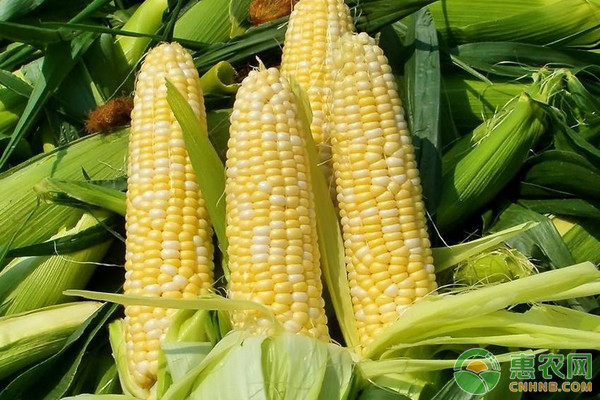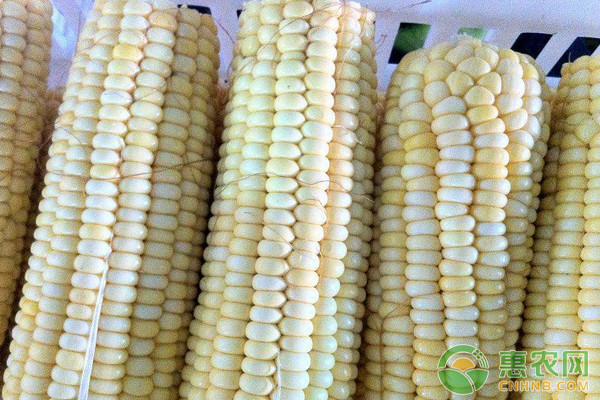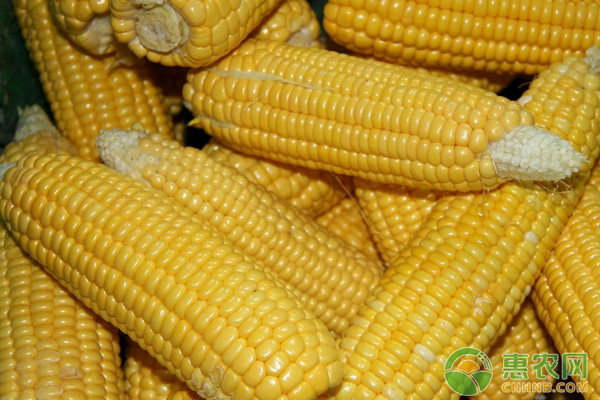Corn is one of the indispensable vegetables in the pursuit of healthy eating, while fresh sweet corn is rich in vitamin C, and the crude fiber content is as high as 16.36%. The “selenium†content is 8 times higher than that of ordinary corn, which is extremely important for enhancing the body's own immune function.

1 The nutritional value of sweet corn
Sweet waxy corn contains a variety of natural vitamins. Regular consumption can lower cholesterol, lower blood pressure, lower blood fat, lower blood sugar, regulate constipation, and skin care.
The fat rich in sweet waxy corn, linoleic acid and calcium can reduce the deposition of cholesterol in blood vessels, soften arterial blood vessels, prevent high blood pressure, coronary heart disease and myocardial infarction. Corn contains calcium, soft phospholipids, selenium, phosphorus and other elements to prevent skin lesions and reduce arteriosclerosis and brain function decline. High corn fiber content can promote intestinal peristalsis, reduce the accumulation of toxic substances in the intestine, effectively improve constipation, reduce hemorrhoid pain, and reduce the incidence of colon and rectal cancer.
Sweet waxy corn is rich in glutamic acid, which is beneficial to the excretion of ammonia in brain tissue. It has good brain-enhancing and memory-enhancing effects; 13 of the 17 amino acids are higher than ordinary corn. The lutein and zeaxanthin contained in corn are beneficial to delay the aging of the eyes.
Sweet corn has good nutritional value and good food quality and is very popular among consumers. Fresh corn can be directly eaten raw (super sweet) or eaten after cooking, stir-fry, or processed into beverages, chips, canned foods and frozen foods.
2 Cultivation techniques
2.1 Preparation before sowing
2.1.1 Strict selection of fine land preparation
Sweet waxy corn requires uniform plant growth and consistent ear size. In particular, sweet corn seeds are dry and shrink, and the ability to germinate arch soil is poor. Therefore, it is advisable to choose sandy loam soil and loam soil with deep soil layer, upper and lower solid, loose structure, fertile soil and capable of discharging energy. Before sowing, it should be finely grounded, and the base fertilizer should be applied. Generally, 60 to 80,000 kilograms of high-quality farmyard manure per hectare is applied, and 225-300 kilograms of nitrogen, phosphorus and potassium compound fertilizer are used as base fertilizer. The spring sowing plot pays attention to the preservation of the soil after deep thawing, so as to create a deep, loose, fine, uniform, fat and wet soil environment.
2.1.2 Choosing the right variety
Choose the fine varieties that meet the local natural and production conditions. The canned sweet corn can be processed with sweet or ordinary sweet corn varieties of yellow or white grains. It is used to process glutinous corn porridge, corn gluten and glutinous corn slag. It is best to use yellow or black. Grain varieties; when harvesting fresh fruits for fruit and vegetable market, super sweet and sweet waxy corn varieties should be used. In order to be able to go public in batches to extend the time to market, to meet market and processing needs, we should choose the appropriate combination of early, middle and late varieties.
2.1.3 Seed treatment
Carefully select seeds and soak seeds before planting. Use seeds with high full germination rate and high purity, remove insects, bad seeds, and mildew seeds, and kill the pathogens of seed epidermis for 2~3 days to improve the germination rate of seeds. At the time of sowing, seed dressing or 50% phoxim emulsifiable concentrate 0.1%~0.2% seed amount is used for seed dressing to control underground pests. Or with titanium-containing micro-fertilizer seed dressing, it can kill harmful microorganisms and pests around the seeds and in the soil. Because the seed coating contains various trace elements and growth agents required for corn, it can promote root development and plant growth, and the seedling rate is also high; titanium fertilizer can promote early fast growth, improve quality and increase yield.

2.2 Scientific sowing
2.2.1 Suitable seeding
The seed germination of sweet waxy corn is not resistant to low temperature. Therefore, the earliest sowing period must start sowing when the temperature is stable through 12 °C. The latest sowing period must also ensure that the temperature during harvesting is above 18 °C. Sometimes in order to extend the time of listing or processing, seeding can be carried out in stages, with early, medium and late varieties. Sweet glutinous corn is particularly sensitive to light and warm climatic conditions. Unsuitable climatic conditions will affect the yield and quality, especially the sweet glutinous corn is not resistant to high temperature during flowering, and the pollen temperature exceeds 37 °C. The pollen mortality is high, and the seed setting rate is high. reduce. In the production, early or late sowing should be adopted, so that the pollination period and the filling stage are staggered in the high temperature season.
2.2.2 Seeding techniques
In order to obtain better economic value, it is possible to adopt plant cultivation techniques such as mulching, seedling transplanting, and greenhouse cultivation, and planting in batches every 5 to 10 days. Live broadcast can take the size of row or equal row spacing, large row spacing 80~90 cm, small row spacing 50~60 cm, depending on the density of the plant, sowing seeds can be 3~5 cm into the soil, sowing 2~3 per hole Granules, 1~1.2 kg per mu, to ensure full seedlings. Suitable for the germination of sweet corn kernels, generally with a soil moisture content of 60% to 75%. Land plots with poor grievances can be taken by ditch artificial on demand. Seeds should be soaked, not soaked too deep to prevent excessive nutrients from being consumed or causing no emergence. In order to ensure that the seedlings are full, strong and even, two or three seeds must be planted at each hole. Do not reduce the amount of seeds because of the high seed price. Spring sowing is best covered with plastic film in the morning; greenhouses and greenhouses should be planted and transplanted, and the seedling age is in the 3rd leaf stage, no more than 25 days, and the survival rate of soil transplanting is high.
2.2.3 Isolation planting, maintaining inertia
Because both sweet corn and waxy corn are single recessive gene mutants of endosperm traits, once they receive pollen from ordinary corn or other corn, they become common corn, losing sweetness and astringency. In particular, purple and black waxy corn receives other corn pollen and becomes flower spikes. Therefore, sweet and waxy corn must be isolated and planted. General isolation can be spatially isolated and time isolated. Space isolation range requirements: sweet corn more than 400 meters, waxy corn more than 300 meters. That is, within 400 meters of the sweet corn field, ordinary sweet corn or other types of common corn and waxy corn that are flowering at the same time as sweet corn cannot be planted. Time isolation is to delay or delay the planting time of corn in the isolation zone, so as to be staggered from the corn flowering period outside the isolation zone. The spring sowing can be separated by 30 days, the summer sowing interval is 20 days, the sowing is too late, and the rate of ear formation is low, which seriously affects the yield.
2.2.4 Reasonable close planting
Reasonable close planting is the central link of high yield of corn. Density should be determined according to the characteristics of the variety, water and fertilizer conditions and climatic conditions. For early maturity, dwarf stalk, leaf rushing, compact plant type, dry land, low terrain, high temperature should be sparsely planted; From the perspective of production practice, to determine the planting density of sweet corn, the commercial traits should be considered first. Because fresh corn is priced in spikes, yield traits are second. When the density is too large, the ear is liable to become smaller, the weight is lighter, and the effective ear is reduced, so that the value of the commodity is greatly reduced. The planting of high-spike and large-earth varieties is rare, and it is better to use single-plant seedlings, which is suitable for harvesting fresh corn ears. For varieties with higher double ear rate, the planting density should not be too large. Prevent the increase of the empty rod rate or the small and falling ears, and reduce the economic benefits. Low-profile spikelets, compact varieties can be properly densely planted.
2.3 Field management
2.3.1 Strengthening management
After the emergence of the maize, the cultivating is carried out in time. During the three-leaf period, the seedling density is 120%~130% of the suitable density; the seedlings are fixed at the five-leaf stage to reach the appropriate density. In combination with fixed seedlings, it is necessary to remove yellow and white seedlings and sick and weak seedlings, and to keep seedlings of the same size. Combined with topdressing, weeding, weeding, watering, and watering. In the seedling stage, it is necessary to prevent waterlogging, and watering should be carried out in the case of drought during heading to filling. Sweet waxy corn is more prone to tiller than ordinary corn, and the resulting tillers generally cannot form effective spikes, so it is necessary to go to the war in time. In production, the phenomenon of one leaf, one ear or one part of multiple ears will occur in the land with good water and fertilizer conditions, and it should be removed in time, leaving 1 or 2 ears per plant to prevent the production of small spikes. Because of the unique flavor of sweet corn, the pollination period is extremely vulnerable to pests such as the big black chafer, and it is necessary to go to the field to catch it regularly every day. At this time, you cannot use pesticides to kill insects.

2.3.2 Application of organic fertilizer and non-polluting water
Sweet corn is not as good as ordinary corn, so it is necessary to apply organic fertilizer and apply nitrogen, phosphorus and potassium fertilizers in a balanced manner. In the production process, pollution-free agricultural products are required to follow the principle of applying organic fertilizer. The fresh corn plant with organic fertilizer is strong, the green tassel seeds are bright and full, the aroma is strong, the sweetness is pure, and the grain is thin and very mouthful. Fresh corn is harvested for the purpose of harvesting the ear of milk, and the total amount of fertilizer can be less than that of ordinary corn.
(1) The yield of fresh ears in high-fertility fields is targeted at 12-15 tons per hectare. The application rates of pure nitrogen, phosphorus and potassium are 150-180 kg, 60-90 kg and 90-120 kg per hectare respectively. The medium and low yield fields can be appropriately increased on this basis.
(2) The amount of pure nitrogen in the base fertilizer accounts for about 50% of the total amount. Phosphorus and potassium fertilizers are all applied as the base fertilizer, and the base fertilizer is concentrated in the ditch or the acupoint application.
(3) The jointing stage and the big bell period should be topdressed in time, with quick-acting nitrogen as the main factor. The application rate of pure nitrogen in jointing stage accounts for about 15% of the total, and the large bell mouth period accounts for about 35%. Irrigation water follows the principle of natural and non-polluting water sources, and does not use industrial wastewater and domestic wastewater.
2.3.3 Artificial assisted pollination
During sweet silky corn, during the loosening of the powder, in case of high temperature, rain and other adverse weather conditions, there are often bald or missing particles. This phenomenon can be avoided by artificially assisted pollination. Artificial pollination is usually carried out every day from 9 to 11 am, every 1 to 2 days, usually 3 to 4 times.
2.3.4 Integrated pest control
Sweet waxy corn is vulnerable to aphids. The following measures can be taken to prevent and cure: the wintering host is eliminated, the stems are treated in time after harvesting, and the stalks can be crushed or reclaimed into the fields or piled up into fertilizers. During the adulthood, black light and sexual attractants are set to trap. At the peak of spawning, release 150,000 heads/ha of Trichogramma, put it once every 5 days, and put it 2~3 times. During the hatching period of the eggs, a uniform spray of Bt emulsion 200 times was used. The heart leaf stage is sprayed with dichlorvos and insecticidal double 800~1000 times for 1~2 times. No further medication is required in the future. Disease control: leaf spot disease 75% chlorothalonil 800 times spray. Silk black ear 15% powder rusting 50 times liquid seeded with 0.1% seed dressing. Pest control: 20% of the underground pests are seeded with corn seed dressing. Corn aphid 10% imidacloprid 10 g / mu spray. Grass damage control: 50% corn treasure 200 ml / acre soil treatment. According to regulations, the production of AA grade green products prohibits the use of organic synthetic chemical insecticides, acaricides, fungicides and plant growth regulators. For Class A green products, there are restrictions on the name and usage of the drug. Therefore, the selection of drugs should be carefully selected in the prevention and control of pests and diseases.
2.4 timely harvest
The appropriate harvesting period should be judged by the characteristics of the variety, the planting area, its use and the characteristics of the climate at that time. According to the days after pollination and grain moisture content, sugar content, combined flavor and taste, the most suitable harvesting period of sweet corn is determined. It is 23~25 days after pollination, and the water content is about 62%. It tastes sweet and fragrant. The best flavor is delicious. Fresh corn is introduced into the milk 25 to 30 days after pollination. At this time, the leaf can be torn open to check the maturity of the seeds. If the tenderness is too high or the old harvest is unfavorable to the quality, timely harvest is the key link to ensure the quality of the product. Because the taste changes with the growth process of the grain. The best season is the most suitable harvest period. Early in the morning, the grain moisture content is too much, the dry matter is too little, the taste is light, the taste is not good, the yield is low, and it is not suitable for preservation. After receiving the night, the sugar in the grain is converted into starch, the seed coat is thickened, the taste is not good, and the flavor is lowered. Slightly tender, suitable for raw food, cooking, quick freezing, etc. On the contrary, it is more suitable for stir-fry and so on. Some of the productions are listed in the market for sale or quick-frozen, frozen in the wrong season, and some are processed canned grains with different purposes. In the normal accumulated temperature year, about 25 days after pollination of waxy corn, about 18 days after pollination of sweet corn is a timely harvesting period, which affects quality too early and too late. It is difficult to preserve the fresh ear of sweet waxy corn. The quality of the sweet corn is easy to change with time. It should be processed in the morning market and processed as soon as possible. The harvesting must be completed within 10 hours. At the same time, the amount of harvest is determined by sales and processing capabilities. If the harvested ears cannot be sold and processed in time, they should be stored at the lowest possible temperature.
The above is the whole content of fresh sweet corn cultivation technology. Welcome everyone to continue to pay attention to the cultivation technology of more corn varieties.
SARS-CoV2(COVID-19) Antigen Rapid Test Kit
NINGBO AUTRENDS INTERNATIONAL TRADE CO., LTD , https://www.metests.com